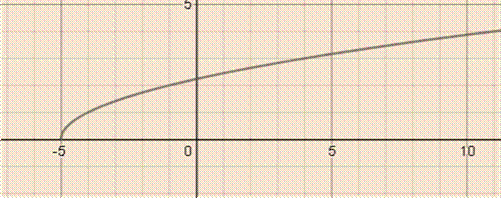
The intercepts, then test for the symmetry and sketch the graph.
Explanation of Solution
Given:
The equation is given as:
The intercept can be determined by putting the value of the other variable equal to the zero.
The x intercept is written as (x,0) and the y-intercept is written as (0,y).
Hence, the x -intercept:
Similarly, the y-intercept:
Therefore, the intercepts are
Now, the test for the symmetry:
Firstly replace the y with the −y and if there is no effect on the equation then the graph will be symmetric with respect to the x-axis.
As equation 1 and 2 are different then the non-symmetric.
Similarly, replace x with −x and if there is no effect on the equation then the graph is symmetric along the y-axis.
As the equation 1 and 2 are not equal, hence the graph is not symmetric along the y-axis.
Now, replacing the x by −x and y by −y, if there is no effect on the equation then the system will be symmetric along the origin.
As the equation 1 and 2 are not equal then the system is not symmetric along the origin also.
Now the graph is drawn as:

Chapter 1 Solutions
EBK PRECALCULUS W/LIMITS
 Calculus: Early TranscendentalsCalculusISBN:9781285741550Author:James StewartPublisher:Cengage Learning
Calculus: Early TranscendentalsCalculusISBN:9781285741550Author:James StewartPublisher:Cengage Learning Thomas' Calculus (14th Edition)CalculusISBN:9780134438986Author:Joel R. Hass, Christopher E. Heil, Maurice D. WeirPublisher:PEARSON
Thomas' Calculus (14th Edition)CalculusISBN:9780134438986Author:Joel R. Hass, Christopher E. Heil, Maurice D. WeirPublisher:PEARSON Calculus: Early Transcendentals (3rd Edition)CalculusISBN:9780134763644Author:William L. Briggs, Lyle Cochran, Bernard Gillett, Eric SchulzPublisher:PEARSON
Calculus: Early Transcendentals (3rd Edition)CalculusISBN:9780134763644Author:William L. Briggs, Lyle Cochran, Bernard Gillett, Eric SchulzPublisher:PEARSON Calculus: Early TranscendentalsCalculusISBN:9781319050740Author:Jon Rogawski, Colin Adams, Robert FranzosaPublisher:W. H. Freeman
Calculus: Early TranscendentalsCalculusISBN:9781319050740Author:Jon Rogawski, Colin Adams, Robert FranzosaPublisher:W. H. Freeman
 Calculus: Early Transcendental FunctionsCalculusISBN:9781337552516Author:Ron Larson, Bruce H. EdwardsPublisher:Cengage Learning
Calculus: Early Transcendental FunctionsCalculusISBN:9781337552516Author:Ron Larson, Bruce H. EdwardsPublisher:Cengage Learning





